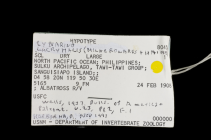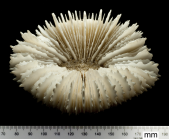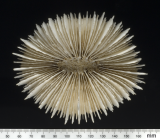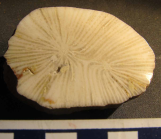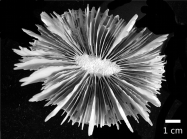
| Intro | | About | | Wiki | | Search traits | | Data explorer | | Literature | | Definitions | | Sources | | Webservices | | Statistics | | Feedback | | Editors | | Log in |
WoRMS taxon detailsAcanthophyllia Wells, 1937
267187 (urn:lsid:marinespecies.org:taxname:267187)
accepted
Genus
Caryophyllia deshayesiana Michelin, 1850 accepted as Acanthophyllia deshayesiana (Michelin, 1850) (type by original designation)
Apostrophyllum Thomas, 1835 † · unaccepted > junior subjective synonym
marine,
Wells JW. (1937). Coral studies: Part II. Five new species of the Madreporaria. Five new genera of the Madreporaria. <em>Bulletins of American Paleontology.</em> 23 (97): 242-250, pl. 2. [details]
Taxonomic remark This genus was synonymized with Cynarina (see Best and Hoeksema, 1987) but since Daris et al (2016) separated Cynarina...
Taxonomic remark This genus was synonymized with Cynarina (see Best and Hoeksema, 1987) but since Daris et al (2016) separated Cynarina lacrymalis from Acanthophyllia deshayesiana, they also separed both species at genus level. Therefore Acanthophyllia became valid again. However, they did not include types in their study and therefore it is not clear which name belongs to each of both species. [details]
Hoeksema, B. W.; Cairns, S. (2025). World List of Scleractinia. Acanthophyllia Wells, 1937. Accessed through: World Register of Marine Species at: https://www.marinespecies.org/aphia.php?p=taxdetails&id=267187 on 2025-07-13
Date action by
Nomenclatureoriginal description
Wells JW. (1937). Coral studies: Part II. Five new species of the Madreporaria. Five new genera of the Madreporaria. <em>Bulletins of American Paleontology.</em> 23 (97): 242-250, pl. 2. [details] original description (of Apostrophyllum Thomas, 1835 †) Thomas HD. (1935). On Tricycloseris, Anabacia, and some new genera of Hexacoralla. <em>The Geological Magazine.</em> 72(9): 424-430. [details] basis of record van der Land, J. (ed). (2008). UNESCO-IOC Register of Marine Organisms (URMO). , available online at http://www.marinespecies.org/urmo/ [details] Taxonomystatus source
Darus RF, Zamani NV, Suharsono, Solihin DD. (2016). <em>Acanthophyllia deshayesiana</em> (Michelin, 1850) coral species is not synonym with <em>Cynarina lacrymalis</em> (Milne Edwards & Haime, 1848). <em>Ilmu Kelautan - Indonesian Journal of Marine Sciences.</em> 21 (3): 107-116., available online at https://doi.org/10.14710/ik.ijms.21.3.107-116 [details] Available for editors Othercontext source (Hexacorallia)
Fautin, Daphne G. (2013). Hexacorallians of the World. (look up in IMIS) [details]
additional source Cairns, S.D., L. Gershwin, F.J. Brook, P. Pugh, E.W. Dawson, O.V. Ocaña, W. Vervoort, G. Williams, J.E. Watson, D.M. Opresko, P. Schuchert, P.M. Hine, D.P. Gordon, H.I. Campbell, A.J. Wright, J.A.Sánchez & D.G. Fautin. (2009). Phylum Cnidaria: corals, medusae, hydroids, myxozoans. <em>in: Gordon, D.P. (Ed.) (2009). New Zealand inventory of biodiversity: 1. Kingdom Animalia: Radiata, Lophotrochozoa, Deuterostomia.</em> :59-101., available online at https://repository.si.edu/handle/10088/8431 [details] Available for editors  Present Present  Inaccurate Inaccurate  Introduced: alien Introduced: alien  Containing type locality Containing type locality
From editor or global species database
Taxonomic remark This genus was synonymized with Cynarina (see Best and Hoeksema, 1987) but since Daris et al (2016) separated Cynarina lacrymalis from Acanthophyllia deshayesiana, they also separed both species at genus level. Therefore Acanthophyllia became valid again. However, they did not include types in their study and therefore it is not clear which name belongs to each of both species. [details]
|
